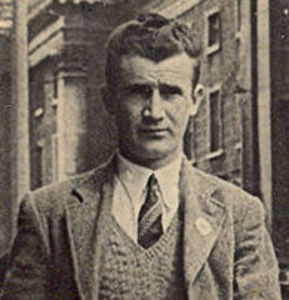Charlie Kerins facts for kids
Charlie Kerins (born Cathal Ó Céirín; January 23, 1918 – December 1, 1944) was an important figure in the Irish Republican Army (IRA). He believed in using force to achieve an independent Ireland. Kerins became the Chief of Staff of the IRA. He was one of six IRA members who were put to death by the Irish government between 1940 and 1944. After being sought by police for two years, he was caught in 1944. Following a trial related to a 1942 shooting incident involving a police officer, Kerins died by execution at Mountjoy Prison in Dublin.
Quick facts for kids
Charlie Kerins
|
|
|---|---|
| Cathal Ó Céirín | |
 |
|
| Chief of Staff of the IRA | |
| In office October 1942 – 16 June 1944 |
|
| Preceded by | Hugh McAteer |
| Succeeded by | Harry White |
| Personal details | |
| Born | 23 January 1918 Caherina, Tralee, County Kerry, Ireland |
| Died | 1 December 1944 (aged 26) Mountjoy Prison, Dublin, County Dublin, Ireland |
| Cause of death | Execution by hanging |
| Criminal status | Executed |
| Conviction(s) | Murder |
| Criminal penalty | Death |
| Military service | |
| Branch/service | Irish Republican Army (1922–1969) |
Contents
Early Life and Education
Charlie Kerins was born in Caherina, a place near Tralee in County Kerry, Ireland. He went to Balloonagh Mercy Convent School and then the Christian Brothers School. When he was 13, he won a scholarship from the Kerry County Council. This allowed him to finish his secondary education at the Green Christian Brothers and the Jeffers Institute.
In 1930, Kerins passed his Intermediate Certificate with high marks. He also passed the exam to enter the National University of Ireland. Later, he studied business and worked in a radio shop in Tralee.
Sports and Community
Kerins was also very active in sports. He played Gaelic football with his local team, O'Rahilly's. In 1939, his team won a county medal. Today, the team is called Kerins O'Rahilly's in his honor. There is also a small park in Tralee named after him.
Joining the IRA
In 1940, Charlie Kerins joined the IRA. By May 1942, he was appointed to their General Headquarters staff. At this time, the Irish government, led by Éamon de Valera, wanted Ireland to remain neutral during World War II.
The IRA's actions, like bombing campaigns in England and ties to Nazi Germany, were seen as a big threat to Ireland's safety. The government took a very firm approach to the IRA. Police raids and questioning were common. Because of this, many IRA members saw the Irish police as a greater enemy than the British.
IRA members who were caught by the police were held in a special camp. This camp was at the Curragh Camp in County Kildare for the rest of the war.
A Serious Incident
On September 9, 1942, a police officer named Detective Sergeant Denis O'Brien was leaving his home in Ballyboden, Dublin. He was shot between his front gate and his car. O'Brien was a very effective detective in the Special Branch Division of the police.
Becoming Chief of Staff and Capture
After another IRA leader, Hugh McAteer, was arrested in October 1942, Charlie Kerins became the Chief of Staff of the IRA. Even though the police searched widely for him, Kerins managed to stay hidden for almost two years.
On July 1, 1943, Charlie Kerins, along with two other men, stopped a van carrying money for wages. They took the van and about £5,000. This money was used to help fund the IRA's activities.
During his time on the run, Kerins stayed at the home of travel writer Dervla Murphy's family in County Waterford. He used the name Pat Carney. Dervla, who was 12 at the time, became friends with him.
Kerins had left some papers and guns hidden at a house in Rathmines, a Dublin suburb. He called the house to get them back. However, the police had listened in on the phone line. On June 15, 1944, Kerins was arrested during an early morning raid. He was asleep and could not reach a weapon hidden under his bed.
Trial and Final Journey
Charlie Kerins was put on trial on October 2, 1944. The trial took place at the Special Criminal Court in Collins Barracks, Dublin. He was charged in connection with the shooting incident involving Detective O'Brien. Kerins refused to accept the court's authority. This meant he gave up his right to challenge evidence or present a defense.
Despite efforts by lawyers and public protests, the government did not change its decision. On December 1, 1944, Kerins was put to death at Mountjoy Prison. He was the last IRA member to die by execution in Ireland.
Kerins was first buried in the prison yard. In September 1948, his remains were moved and given back to his family. Large crowds gathered in towns and villages as his body was brought home from Dublin. Charlie Kerins was finally laid to rest in his hometown of Tralee. He is buried in the Republican Plot at Rath Cemetery, Tralee, County Kerry.
A famous Irish rebel song called 'The Boy from Tralee' was written about Charlie Kerins and his story.

